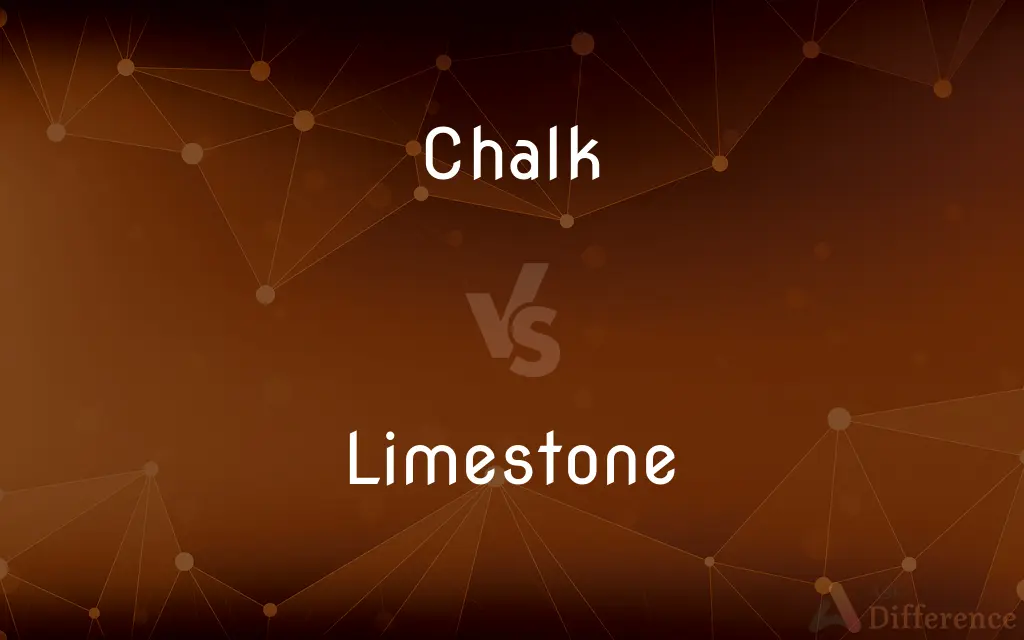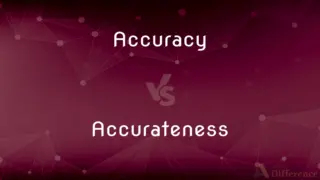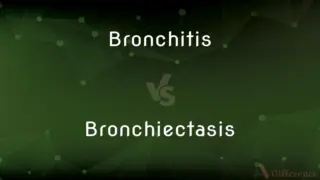Chalk vs. Limestone — What's the Difference?
By Maham Liaqat & Urooj Arif — Updated on March 11, 2024
Chalk is a soft, white limestone variant, formed from the skeletal remains of marine organisms, while limestone is a broader category of sedimentary rock composed mainly of calcite, encompassing various forms including chalk.

Difference Between Chalk and Limestone
Table of Contents
ADVERTISEMENT
Key Differences
Chalk is characterized by its softness and white color, typically found in areas that were once deep sea beds. It is made up almost entirely of calcite from the microscopic shells of marine organisms. Limestone, on the other hand, is a more diverse group of sedimentary rocks that can vary greatly in color, hardness, and origin, including not just organic remains but also precipitates from mineral-rich waters.
The formation of chalk is a specific geological process that occurs under marine conditions, leading to the accumulation of calcite from the shells of coccolithophores and other microscopic marine life. Limestone's formation encompasses a broader range of environments, including marine settings, freshwater, and even hot springs, resulting from both biological and chemical processes.
Chalk is often used in classrooms and art for writing on blackboards and sidewalks due to its softness and ease of marking surfaces. Limestone has a wider range of applications, including as a major component in cement, in the construction industry for building materials, and in agriculture to adjust soil pH.
The porosity and permeability of chalk make it a significant aquifer in some regions, providing water storage and supply. Limestone, depending on its formation and subsequent geological processes, can vary in porosity and permeability, influencing its use in construction and its role in natural water filtration systems.
Despite their differences, both chalk and limestone play crucial roles in ecosystems. Chalk cliffs, for example, support unique habitats, while limestone regions are known for karst landscapes, which include features like caves, sinkholes, and underground rivers, contributing to biodiversity and geological interest.
ADVERTISEMENT
Comparison Chart
Composition
Calcite from microscopic marine organisms
Calcite, may include other minerals
Texture
Soft, fine-grained
Varies, from fine to coarse-grained
Color
Typically white
Can be white, gray, black, tan, pink
Formation Environment
Marine settings
Marine, freshwater, hot springs
Uses
Writing materials, art
Construction, cement, agriculture, art
Permeability
High in some forms
Varies significantly
Ecological Role
Supports specific marine habitats
Supports diverse ecosystems, karst landscapes
Compare with Definitions
Chalk
A soft, white limestone used for writing and drawing.
The teacher wrote on the blackboard with a piece of chalk.
Limestone
A sedimentary rock mainly composed of calcite.
The limestone facade of the building stood out magnificently.
Chalk
Serves as a natural water filter in aquifers.
The chalk aquifer supplies clean drinking water to the region.
Limestone
Varies in color and hardness.
The landscape was dotted with gray limestone boulders.
Chalk
Found in specific marine environments.
The White Cliffs of Dover are a famous chalk formation.
Limestone
Used extensively in construction and industry.
Limestone is a primary ingredient in cement production.
Chalk
Forms from marine organism remains.
Chalk cliffs are composed of millions of coccolithophores.
Limestone
Forms in diverse environments.
Limestone caves were formed from mineral-rich water percolating through the ground.
Chalk
Used in agriculture to improve soil.
Farmers spread chalk on fields to reduce acidity.
Limestone
Supports karst topographies with unique ecosystems.
The limestone region is known for its deep caves and sinkholes.
Chalk
Chalk is a soft, white, porous, sedimentary carbonate rock, a form of limestone composed of the mineral calcite and originally formed deep under the sea by the compression of microscopic plankton which had fallen to the sea floor. Chalk is common throughout Western Europe, where deposits underlie parts of France, and steep cliffs are often seen where they meet the sea in places such as the Dover cliffs on the Kent coast of the English Channel.
Limestone
Limestone is a common type of carbonate sedimentary rock. It is composed mostly of the minerals calcite and aragonite, which are different crystal forms of calcium carbonate (CaCO3).
Chalk
A white soft earthy limestone (calcium carbonate) formed from the skeletal remains of sea creatures.
Limestone
A common sedimentary rock consisting mostly of calcium carbonate, CaCO3, used as a building stone and in the manufacture of lime, carbon dioxide, and cement.
Chalk
Short for French chalk
Limestone
An abundant rock of marine and fresh-water sediments; primarily composed of calcite (CaCO3); it occurs in a variety of forms, both crystalline and amorphous.
Chalk
Write or draw with chalk
He chalked a message on the board
Limestone
Pertaining to or made of limestone.
Chalk
Charge (drinks bought in a pub or bar) to a person's account
He chalked the bill on to the Professor's private account
Limestone
A rock consisting chiefly of calcium carbonate or carbonate of lime. It sometimes contains also magnesium carbonate, and is then called magnesian or dolomitic limestone. Crystalline limestone is called marble.
Chalk
A soft compact calcite, CaCO3, with varying amounts of silica, quartz, feldspar, or other mineral impurities, generally gray-white or yellow-white and derived chiefly from fossil seashells.
Limestone
A sedimentary rock consisting mainly of calcium that was deposited by the remains of marine animals
Chalk
A piece of chalk or chalklike substance in crayon form, used for marking on a blackboard or other surface.
Chalk
(Games) A small cube of chalk used in rubbing the tip of a billiard or pool cue to increase its friction with the cue ball.
Chalk
A mark made with chalk.
Chalk
Chiefly British A score or tally.
Chalk
To mark, draw, or write with chalk
Chalked my name on the blackboard.
Chalk
To rub or cover with chalk, as the tip of a billiard cue.
Chalk
To make pale; whiten.
Chalk
To treat (soil, for example) with chalk.
Chalk
(uncountable) A soft, white, powdery limestone (calcium carbonate, CaCO3).
Chalk cliffs are not recommended for climbing
Chalk
(countable) A piece of chalk, or nowadays processed compressed gypsum (calcium sulfate, CaSO4), that is used for drawing and for writing on a blackboard (chalkboard).
The chalk used to write on the blackboard makes a squeaky sound
Chalk
Tailor's chalk.
Chalk
A white powdery substance used to prevent hands slipping from holds when climbing, or losing grip in weight-lifting or gymnastics, sometimes but not always limestone-chalk, often magnesium carbonate (MgCO3).
When working out your next move, it's a good idea to get some more chalk from the bag
Chalk
A platoon-sized group of airborne soldiers.
Chalk
The favorite in a sporting event.
Chalk
The prediction that there will be no upsets, and the favored competitor will win.
Chalk
To apply chalk to anything, such as the tip of a billiard cue.
Chalk your hands before climbing
Chalk
To record something, as on a blackboard, using chalk.
Chalk
To use powdered chalk to mark the lines on a playing field.
Chalk
(figuratively) To record a score or event, as if on a chalkboard.
Chalk
To manure (land) with chalk.
Chalk
To make white, as if with chalk; to make pale; to bleach.
Chalk
A soft, earthy substance, of a white, grayish, or yellowish white color, consisting of calcium carbonate, and having the same composition as common limestone.
Chalk
Finely prepared chalk, used as a drawing implement; also, by extension, a compound, as of clay and black lead, or the like, used in the same manner. See Crayon.
Chalk
To rub or mark with chalk.
Chalk
To manure with chalk, as land.
Chalk
To make white, as with chalk; to make pale; to bleach.
Let a bleak paleness chalk the door.
Chalk
A soft whitish calcite
Chalk
A pure flat white with little reflectance
Chalk
Amphetamine used in the form of a crystalline hydrochloride; used as a stimulant to the nervous system and as an appetite suppressant
Chalk
A piece of chalk (or similar substance) used for writing on blackboards or other surfaces
Chalk
Write, draw, or trace with chalk
Common Curiosities
Can chalk and limestone be found in the same geological areas?
Yes, they can coexist in regions where sedimentary layers of different compositions are present.
Is chalk only used for writing?
No, it also finds applications in agriculture and art, among other uses.
What distinguishes chalk from other forms of limestone?
Chalk is softer and typically white, formed from marine organisms, unlike other limestone types.
Are all limestone regions prone to forming caves?
Not all, but limestone is especially susceptible to erosion that forms caves and karst landscapes.
Is chalk considered a renewable resource?
No, it forms over geological timescales, making it non-renewable.
How does the formation of chalk differ from that of other limestones?
Chalk forms in deep marine conditions from the accumulation of microorganism shells, unlike other limestone types.
How does limestone contribute to soil health?
It can adjust soil pH, improving fertility and crop yields.
Can the color of limestone vary?
Yes, depending on its mineral content, limestone can range from white to black.
Why is limestone valued in construction?
Its durability and versatility make it suitable for various construction materials.
Why are karst landscapes associated with limestone?
Limestone's solubility in water leads to the formation of karst features like caves and sinkholes.
Do chalk and limestone have similar chemical compositions?
Yes, both are primarily composed of calcite.
How are chalk and limestone formed?
Both are sedimentary rocks, but chalk specifically forms from the calcite shells of marine organisms.
Can limestone affect water quality?
Yes, it can naturally filter water, improving its quality.
Is it easy to carve chalk?
Yes, due to its softness, chalk is easier to carve than harder limestone varieties.
What role does chalk play in agriculture?
It's used to reduce soil acidity, benefiting plant growth.
Share Your Discovery

Previous Comparison
Accuracy vs. Accurateness
Next Comparison
Bronchitis vs. BronchiectasisAuthor Spotlight
Written by
Maham LiaqatCo-written by
Urooj ArifUrooj is a skilled content writer at Ask Difference, known for her exceptional ability to simplify complex topics into engaging and informative content. With a passion for research and a flair for clear, concise writing, she consistently delivers articles that resonate with our diverse audience.















































